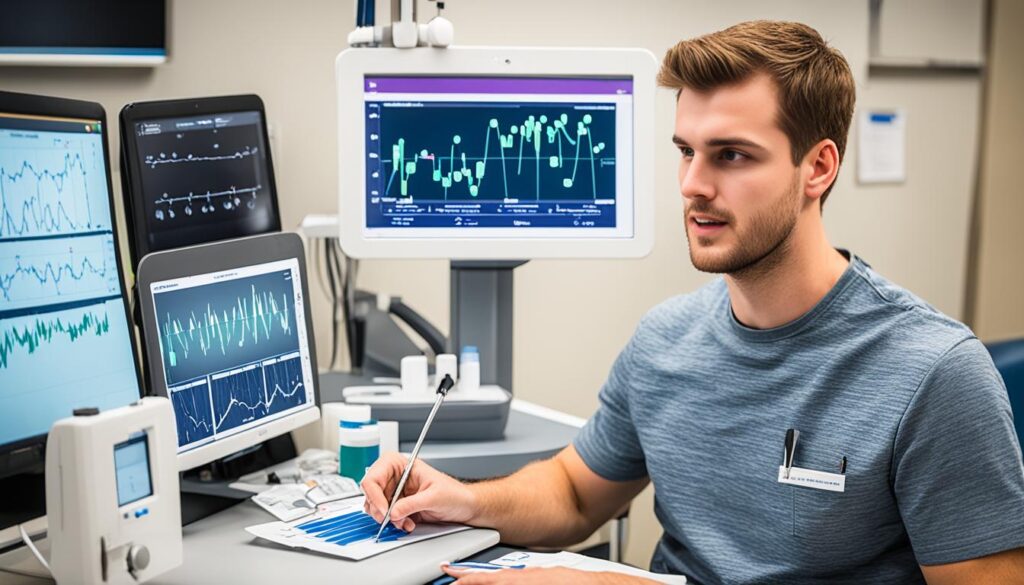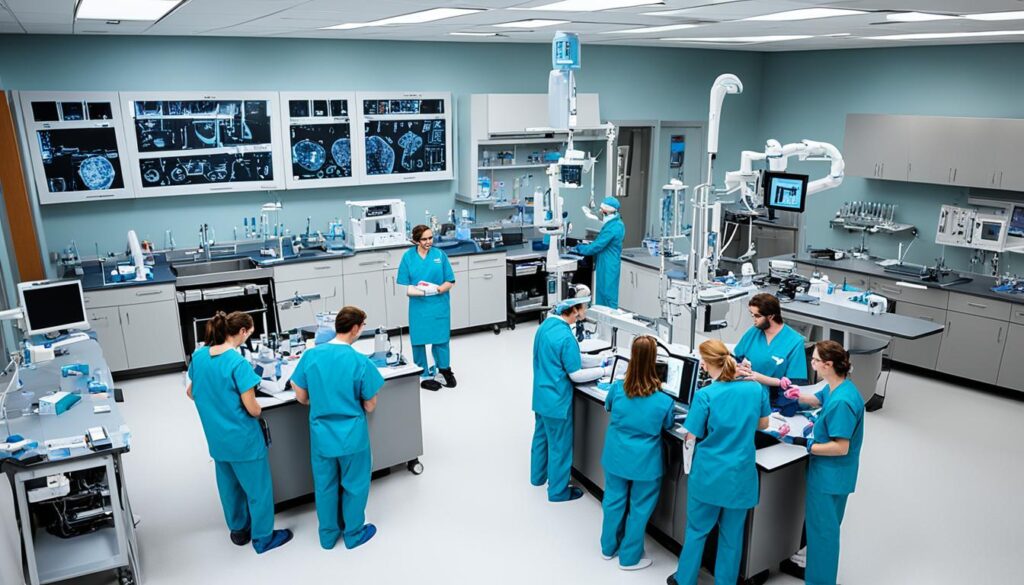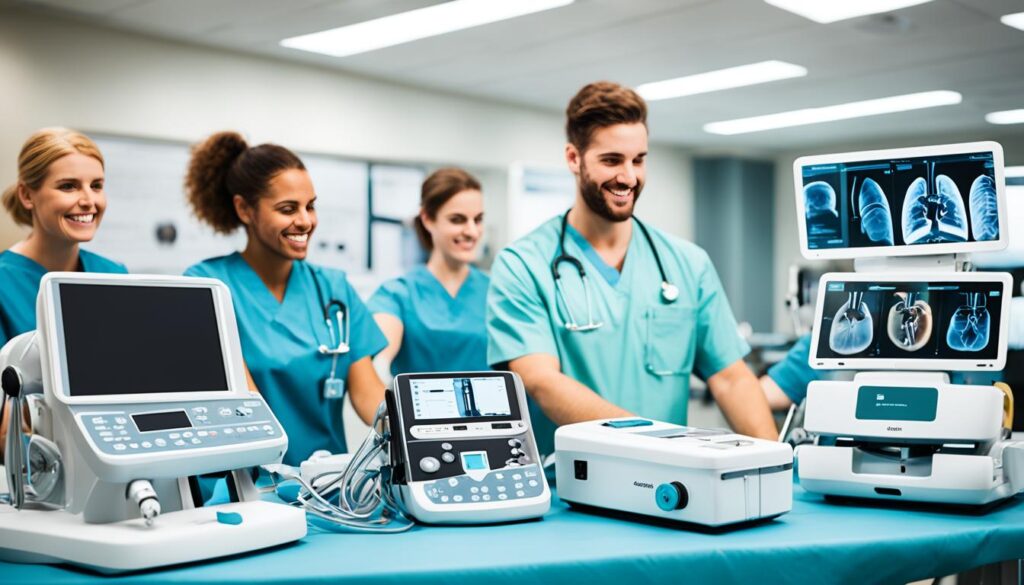“As an Amazon Associate I earn from qualifying purchases.” .
Have you ever thought about what pushes healthcare tech forward? It’s the work of skilled pros. The healthcare field is growing, needing experts who can handle advanced medical gear. Medical tech programs are your entry to this exciting career. This article will show you the best training options in healthcare tech education. It highlights their importance and how they ready you for a rewarding job in medical technology.
If you’re looking to get a degree in medical device tech, specialize in biomedical tools, or get certified in diagnostic equipment, there are many paths. MedCerts leads the way, offering top online courses. They’re known for high quality and forward-thinking, with a 4.4+ rating and many honors, showing the strength of online learning in healthcare tech.
Key Takeaways
- MedCerts has a network of over 1,000 employer partners, offering robust job placement opportunities.
- Graduates of MedCerts programs benefit from industry expert Career Coaches who guide them towards successful careers.
- MedCerts’ online learning programs are highly rated, with a 4.4+ satisfaction score from students.
- The programs employ innovative technologies, such as AI in health tech, which have earned several industry awards.
- MedCerts’ training solutions are proven to deliver results across academic institutions, healthcare organizations, and workforce agencies.
Introduction to Medical Tech Programs
Medical tech programs are key for those wanting to enter healthcare. They teach how to use advanced medical gear. These programs mix learning from doing with classroom theory.
Defining Medical Tech Programs
Medical tech programs offer a wide range of courses for students. You’ll study medical terminology, anatomy, physiology, and how to work in labs. By finishing 20 semester credit hours, students get accredited certifications to show their skills. For example:
| Course Code | Course Name | Credits |
|---|---|---|
| MED101 | Medical Terminology | 3 |
| MED140 | Anatomy and Physiology I | 3 |
| MED142 | Clinical Procedures I | 4 |
| MED141 | Anatomy and Physiology II | 3 |
| MED143 | Clinical Procedures II | 4 |
| MED144 | Lab Procedures | 3 |
| Degree Type | Duration | Common Courses |
|---|---|---|
| Certificate/Dipl¬oma | A few weeks to a year | Basic Medical Procedures, Phlebotomy |
| Associate Degree | Two years | Hematology, Microbiology, Clinical Chemistry |
| Bachelor’s Degree | Four years | Genetics, Biostatistics, Molecular Biology |
Online options offer great flexibility, especially for those with some experience. These combine web-based classes with practical work in hospitals or labs.
Programs Focused on Patient Monitoring Systems Education
Learning about patient monitoring systems is key in today’s healthcare. Professionals must know how to manage advanced medical tech. These programs teach students to use and look after equipment that tracks patient health. As healthcare gets more advanced, this training becomes more critical.

Core Subjects Covered
The curriculum covers important topics like medical device tech, analyzing patient data, and ensuring data accuracy. Students practice with real equipment and learn how to read vital signs correctly. For instance, programs at the University of Southern California and Columbia University teach about wearable and implanted monitors.
They also explore topics like artificial intelligence in healthcare. This is getting more important in the field.
Future Job Prospects
Graduates have bright job prospects. For example, over 200 job openings were presented at the Cornell University healthcare IT job fair. Funding from the Office of the National Coordinator for Health Information Technology (ONC) supports educational programs at places like UCLA and the University of Minnesota. This increases job opportunities.
As healthcare tech develops, the demand for trained professionals in patient monitoring grows. This opens up many career options in healthcare for graduates. It offers them a chance to have a meaningful impact on patient care.
Learning Medical Imaging Technology Curricula
The medical imaging tech courses mix tough theory lessons with hands-on practical training. Students learn to use advanced tools like MRI, CT, and ultrasound machines. This approach makes sure they are ready for their future careers.
Practical Training Elements
Practical training is a key part of learning medical imaging. Specific program areas need 30.0 credits. But the Ultrasound Program needs 46.0 credits. This intense training prepares students for the real world. They become experts in using complex medical imaging tools.
Certification and Accreditation
After finishing 120 credit hours, students can get certified. This step is important for their careers. Certification shows they have the needed knowledge and skills. It’s often needed by employers. Getting certified makes them more employable and credible in healthcare.
Top students may also get recommended for special degrees. This adds a prestigious title to their professional life. It’s a big achievement.
Advantages of Telemedicine Technology Programs
Telemedicine technology programs are changing healthcare for the better. They offer deep insights into providing care from afar. This makes medical help more reachable and speeds up the process.
The Rise of Telemedicine
Telemedicine connects patients with doctors through video or phone. This became very important during the COVID-19 crisis. More health groups are now offering telehealth, making it easier to get.
With better tech, these services are easy to use, even for tech newbies. People can use MyChart or apps for virtual visits. This brings benefits like ease, comfort, and no need for in-person visits.
Telemedicine prevents diseases like COVID-19 and flu from spreading. It allows doctors to check patients first online. It’s also good for specialties, showing practitioners patients’ homes.
It lets far-away family join consultations. This helps a lot with regular care and managing long-term illnesses. It makes it simple for both new and current patients to meet doctors online.
| Statistic | Insight |
|---|---|
| 33-41% | Reduction in healthcare disparities supported by telemedicine in New York during COVID-19 (Chunara et al., 2021). |
| 65-70% | Positive outcomes for telemedicine in healthcare (Flumignan et al., 2019). |
| 25-35% | Improved cost-effectiveness in healthcare systems for depressive disorders (Lokkerbol et al., 2014). |
| 15-20% | Cost reduction in the healthcare system through telemedicine (Charles, 2000). |
| 80-85% | Success rate based on opportunities identified for telemedicine, telehealth, and mobile health applications (Weinstein et al., 2014). |
| 90-110% | Reimbursement rates for outpatient telemedicine services compared to in-person visits (Lin et al., 2020). |
| 75-80% | User satisfaction with asynchronous telemedicine in Santa Catarina’s telemedicine system (Von Wangenheim et al., 2012). |
| 50-55% | Success rate in cost-effectiveness for telemedicine programs (Whitten et al., 2002). |
| 53% | Growth in telehealth usage across the U.S. from 2016 to 2017 (FAIR Health national study). |
Key Skills Acquired
Telemedicine programs teach important skills for today’s healthcare. These skills are needed now.
- Digital Communication: Learn how to communicate remotely in an efficient way.
- Remote Patient Monitoring: Master tracking and managing health data from afar.
- Data Management: Learn how to securely manage huge amounts of patient data.
These essential skills from telemedicine programs prepare you for the future of healthcare. You’ll stay at the forefront of the field.
Making the Most of Clinical Engineering Programs
Clinical engineering programs are key in better healthcare tech management. By getting clinical engineers involved early, healthcare facilities see big financial gains. These programs train experts in keeping medical tech running well, which ensures top-notch patient care.
Clinical engineering experts check service contracts for in-house handling before they’re up for renewal. This saves a lot of money. Working with them when buying new equipment helps understand total costs, improves investment returns, and aids in planning budgets wisely.
Having trained engineers manage everything from installation to disposal cuts costs and saves money. These pros offer insights on equipment status, support options, and ways to save money throughout the equipment’s life. Teaming up with clinical engineering programs early means these savings keep helping over time.
A strong in-house clinical engineering team improves customer service and supplier relationships. Their knowledge makes operations smoother and builds trust with equipment makers. Plus, when it’s time to get rid of equipment, clinical engineers can find buyers or selling options, boosting the facility’s finances further.
| Key Benefit | Description |
|---|---|
| Cost Savings | Identifying in-house service opportunities before contract renewals. |
| Early Involvement | Enhances financial outcomes through strategic planning and contracting. |
| Total Cost of Ownership | Helps determine cost-effectiveness and maximize ROI in new acquisitions. |
| Life Cycle Management | Reduced expenses through effective oversight from installation to disposal. |
| Customer Service | Improved relationships with suppliers and better service management. |
| Maximizing Disposal Revenue | Identifies sales avenues for used equipment to boost revenue. |
Conclusion
Medical tech programs are more than just courses. They’re routes that shape the future of healthcare. By joining these programs, graduates start on paths that boost their lives and those they care for.
The need for a well-planned education in medical technology is clear. Graduates deal with advanced equipment to keep healthcare top-notch. A detailed and ongoing look at medical tech is key. It stops the spread of wrong information.
Progress in healthcare often comes from teamwork and new financial plans. This is especially true for treating heart disease. But to truly make a difference, new tech must be used faster. Medical tech programs ready future pros with the skills to do this.
To improve patient care, we need solid tech evaluation systems. Trained graduates can then choose wisely, cutting costs of low-quality tech. Their education ensures they’re ready for healthcare’s future challenges.
FAQ
What are medical tech programs?
Why are medical tecn programs significant in healthcare?
What healthcare technology education options does MedCerts offer?
What makes American Career College a notable institution for healthcare training?
What are essential courses in medical equipment training?
What is covered in specialized training in diagnostic equipment certifications?
What subjects are covered in patient monitoring systems education?
What are the job prospects for those trained in patient monitoring systems?
What practical training elements are included in medical imaging technology curricula?
How important are certifications and accreditations in medical imaging technology?
What advantages do telemedicine technology programs offer?
What key skills are acquired from telemedicine technology programs?
What are the benefits of clinical engineering programs?
“As an Amazon Associate I earn from qualifying purchases.” .





